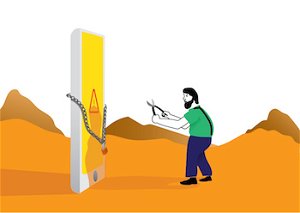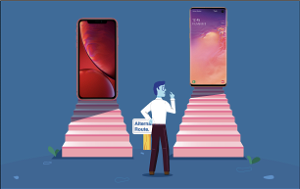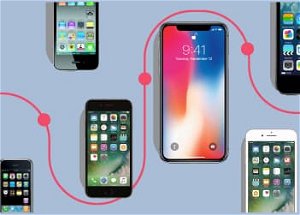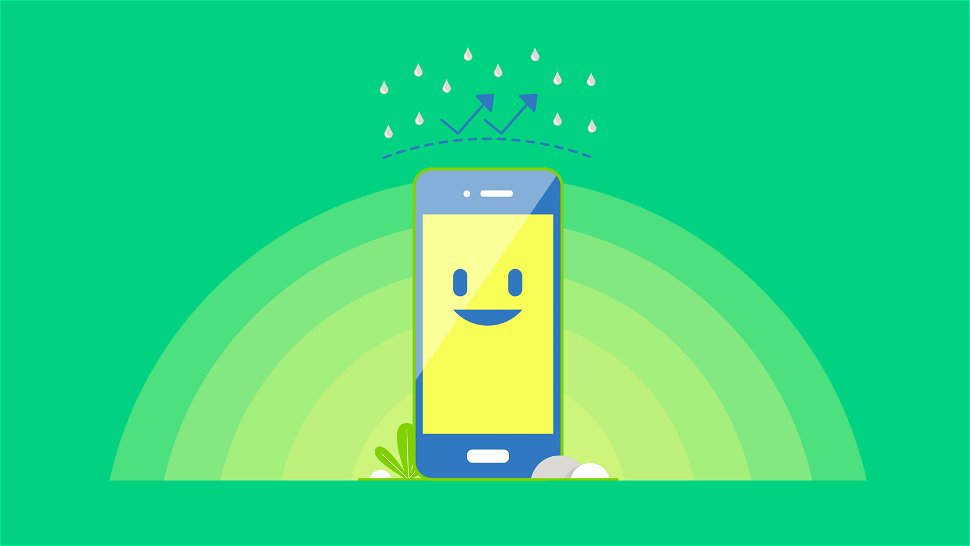
Most major phone and electronics releases these days make a point to hype up that you can run the phone underwater or drop it in the sink without having a really expensive paperweight afterward.
But most ads don’t dive into specifics so you look up the specs to see just how water-resistant that new phone or gadget is...
IP67, IP68, IP8, IPX7... what do these ratings mean?
They certainly don’t tell you much at first glance, but they’re actually quite informative if you know what the numbers and their placement mean.
We’re going to break down everything you need to know so you can understand exactly what to expect -- and what any electronic device you’re considering will handle.
Editor’s Note: This post has been updated for 2022
IP Ratings Explained
IP stands for Ingress Protection. Its essentially a measure of how hard it is for various things to get into an electronic device’s case -- predominantly dust and water.
While often seen in phone specifications, the standards are actually for a whole range of electronic devices.
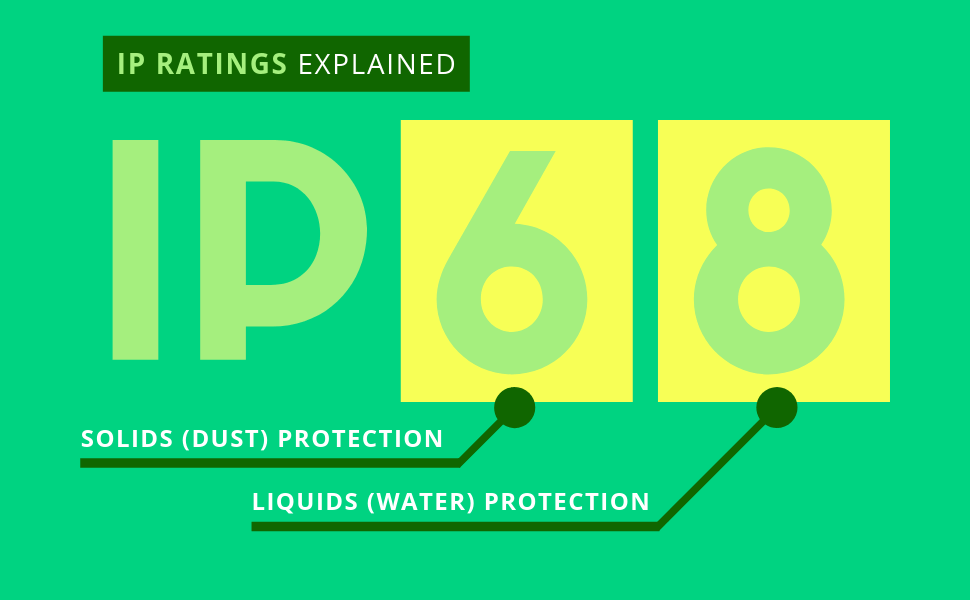
In most cases, the IP rating consists of two numbers. The first describes protection against solids. The second number describes protection against liquids.
Solids Protection Numbers and Their Meanings
| # | Description |
| 0 | No protection |
| 1 | Protection against objects up to 50mm. Also, protection against any large surface of the body, such as the back of the hand, but no protection against deliberate contact with a body part. |
| 2 | Protection against objects up to 12.5mm, along with fingers or similar objects |
| 3 | Protection against objects up to 2.5mm, such as thick wires or tools |
| 4 | Protection against objects up to 1mm, including most wires and screws |
| 5 | Not entirely protected from dust, but enough to significantly affect performance significant damage |
| 6 | Totally protected against dust |
If you see an X in place of the first number (i.e. IPX7) this means the device hasn’t been tested for protection against solids. However, that doesn’t mean it isn’t resistant.
In fact, most phones, Bluetooth speakers, smartwatches, and tablets by their nature fall within the IP3 to IP5 range without any extra design considerations by the manufacturer.
Liquids Protection Numbers and Their Meanings
| # | Description | Examples |
| 0 | No protection |
None |
| 1 | Minimal protection against vertical drops of water, such as very light rain |
Light rain |
| 2 | Protected by vertical drops of water when the device is tilted at 15° from its normal position |
Light rain |
| 3 | Protection against sprays of water when the device is tilted at 60° from its usual position, including rain |
Rain and spraying |
| 4 | Protection from sprays and splashes of water from any direction |
Rain, spraying, and splashing |
| 5 | Protection against water sprayed directly from a low-pressure nozzle measuring 6.3mm, from any direction |
Rain, splashing, and direct contact with most kitchen/bathroom faucets |
| 6 | Protection from high-powered water jets with a 12.5mm nozzle, from any direction, such as a shower |
Rain, splashing, direct contact with kitchen/bathroom faucets, and outdoor use in rough sea conditions |
| 7 | Protected for up to 1m of immersion for up to 30 minutes, including splashing from a shower or an accidental (and brief) dunking |
Rain, splashing, and accidental submersion |
| 8 | Protection against submersion beyond 1m. May mean that device is hermetically sealed or merely that any water that can get inside will cause no damage |
Rain, splashing, and accidental submersion |
As with protections against solids, seeing an X in the second place of the IP rating does not mean it is not water-resistant, merely that it was not tested.
However, unlike the solids protections designation, with the sensitive nature of electronics and water exposure, you should assume that no IP rating means you should avoid moisture when at all possible.
Putting Things Together
By looking at both numbers, you can get an idea of how well your phone will resist various solid and liquid hazards.
For example, an IP67 phone by definition is:
- Totally protected against dust
- Protected for up to 1m of immersion for up to 30 minutes, including splashing from a shower or an accidental (and brief) dunking.
But there is something critical to note here…
Just because a phone is rated for a certain number DOES NOT mean it is rated for the numbers below.
This is why you’ll sometimes see ratings such as IP65/IP67.
This phone would be the same as the example above but also have protection against water sprayed directly from a low-pressure nozzle measuring 6.3mm, from any direction.
So while the first phone might work if dropped in a puddle or the sink, it wouldn’t last if it took a direct hit in the shower. Whereas the second phone should allow you to enjoy your favorite tunes in the shower with no worries.
IPX8: The Wildcard of IP Ratings
While most of the ratings give you a solid idea of what to expect, IPX8 is more complicated.
It’s sort of the catch-all rating for anything better than IPX7...
This means that you’ll see a range of devices which are IP68 rated but actually offer drastically different water-resistance. Some might be good for 6.6 feet or 2 meters while others are good for 100 feet or 30 meters.
Unfortunately, there’s no way to tell just by reading the IP rating. You’ll need to see what the manufacturer says in their marketing or check out some reviews.
Common Questions
1. Are IP-rated devices really waterproof?
In most cases, no. They’re merely water-resistant.
In general, we don’t recommend taking any phone, speaker, or smartwatch you can’t afford to replace into the water for extended periods.
If you're looking to use a Bluetooth speaker near water, be sure it's out of the splash zone unless it's specifically made to float.
In fact, unless it’s IP68-rated, we don’t recommend getting them wet on purpose at all. You might be okay for humidity from a quick shower or a surprise splash of rain, but anything else could spell trouble.
2. What happens if my IP-rated device is water damaged?
This will vary depending on your device and if you have insurance.
While most manufacturers list IP ratings for their phones, very few actually cover liquid damage in their warranties.
Manufacturer support for smartwatches and Bluetooth speakers are little better, but still hit-or-miss.
The same extends to insurance. Be sure to check terms before signing up or hitting the water. Many insurance policies which include “accidental damage” will cover water damage while most standard plans do not.
3. Why aren’t some devices rated but list water resistance in their marketing?
You’ll occasionally run across phones, speakers, and other devices which claim they are water-resistant on some level but don’t list a rating.
Obtaining a rating for an electronic device requires additional time and money. If it's only protected against quick splashes or the like, it might not be worth it to manufacturers to add to the cost as OnePlus recently explained to TechRadar.
However, given that many manufacturers do not cover water damage for IP-rated phones and other electronic devices, the difference between having a rating or not might make little difference in the final outcome.
The best bet is to keep your electronics dry.
4. If my phone or other electronic device is water-resistant, is it also coffee-resistant or mud-resistant?
Not necessarily…
The IP rating process typically covers relatively clean, room temperature water in their tests. They don’t account for the heat from a cup of coffee, the sugar in your favorite soda, the salt in the ocean, or the chlorine in your pool.
While you might not see any direct damage from liquid exposure at first, the residue from a spill or dunk could lead to further issues which the rating wasn’t accounting for.
The same goes for things like dirty river water or mud.
While the water might not hurt things right away, that doesn’t mean dried dirt can’t mess up charging ports, damage headphone jacks, scratch displays, or otherwise cause problems later.
5. Is there any way to make my electronics with no IP rating more water-resistant?
Yes!
Depending on what you're looking to protect, you’ll likely find a number of waterproof case options to help keep your them safe from splashes and dunks.
For newer phones and top-tier phones -- such as the iPhone or Samsung Galaxy S-series -- you can probably find a case made specifically for your phone.
You can find out more in our roundup of the best waterproof cases.
However, there are also universal cases that work like dry bags to protect a wide range of electronics.
Bluetooth speakers are the main exception to this. They're often too large to fit in these bags. However, many brands make high-quality waterproof Bluetooth speakers for use by the pool, river, or beach.
Final Thoughts
You can learn a lot about your electronics by their IP rating.
However, even with a high IP rating, you have little recourse should your phone, tablet, or smartwatch die after a drop in the pool or a spilled cup of coffee.
If you’re looking to add protection to unrated devices before a day at the beach or pool, you’ll find a number of cases out there which meet or exceed the built-in protection of most IP-rated items.
But at the end of the day, whether your phone, tablet, or speaker is rated or not, the best option is to avoid getting it wet whenever possible. Think of IP ratings more like emergency coverage and less like a feature to use often.
Electronics and water just don’t mix and that’s not likely to change in the future.
Disclosure: You should know that in some cases, we may receive a referral fee (at no additional cost to you) for products purchased through the links on our site. These links help support our work but they do not influence our content. Our editorial recommendations are always genuine and we try to feature only the best products and services. Why trust us?
[1] Android Authority: Waterproof Tech: Everything You Need to Know about IP and ATM Ratings
[2] TechRadar: OnePlus Explains Why Its Phones Don’t Get Given an IP Rating
[3] Wired UK: IP Ratings for Waterproof Phones: What Do They Mean?
[4] Mashable India: Explained: Smartphone Waterproofing and IP Ratings
[5] The Lowdown: Is My Phone Waterproof? IP Ratings Explained
[6] Trusted Reviews: IP67 vs IP68: Waterproof IP Ratings Explained
[7] CNet: How Waterproof Is Your Android Phone or iPhone? Here’s What IP68 and IP67 Ratings Mean
[8] The Enclosure Company: IP Rated Enclosures Explained



